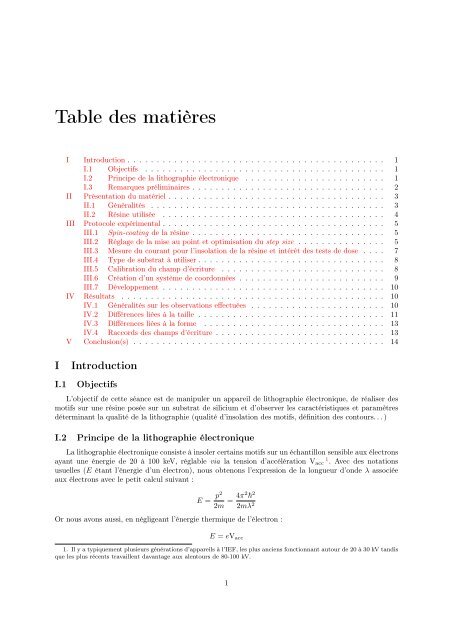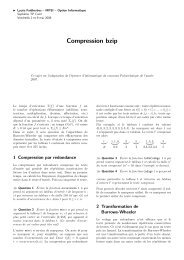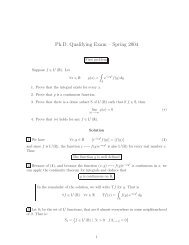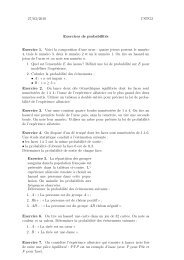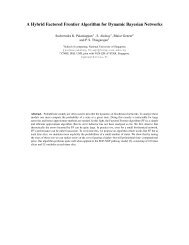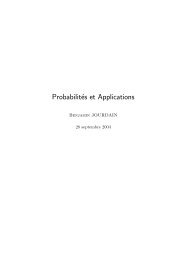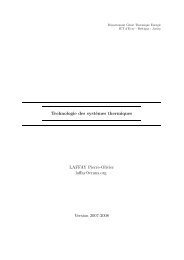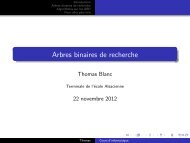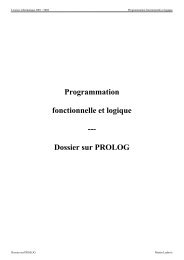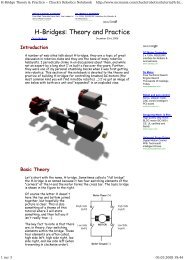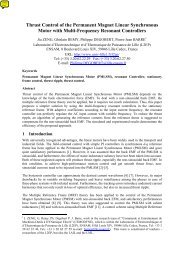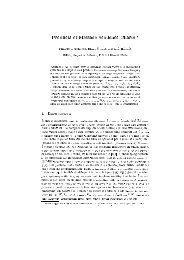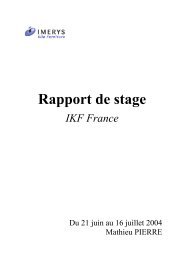Table <strong>de</strong>s matièresI Introduction . . . . . . . . . . . . . . . . . . . . . . . . . . . . . . . . . . . . . . . . . . . . 1I.1 Objectifs . . . . . . . . . . . . . . . . . . . . . . . . . . . . . . . . . . . . . . . . . 1I.2 Principe <strong>de</strong> la lithographie électronique . . . . . . . . . . . . . . . . . . . . . . . . 1I.3 Remarques préliminaires . . . . . . . . . . . . . . . . . . . . . . . . . . . . . . . . . 2II Présentation du matériel . . . . . . . . . . . . . . . . . . . . . . . . . . . . . . . . . . . . . 3II.1 Généralités . . . . . . . . . . . . . . . . . . . . . . . . . . . . . . . . . . . . . . . . 3II.2 Résine utilisée . . . . . . . . . . . . . . . . . . . . . . . . . . . . . . . . . . . . . . 4III Protocole expérimental . . . . . . . . . . . . . . . . . . . . . . . . . . . . . . . . . . . . . . 5III.1 Spin-coating <strong>de</strong> la résine . . . . . . . . . . . . . . . . . . . . . . . . . . . . . . . . . 5III.2 Réglage <strong>de</strong> la mise au point et optimisation du step size . . . . . . . . . . . . . . . 5III.3 Mesure du courant pour l’insolation <strong>de</strong> la résine et intérêt <strong>de</strong>s tests <strong>de</strong> dose . . . . 7III.4 Type <strong>de</strong> substrat à utiliser . . . . . . . . . . . . . . . . . . . . . . . . . . . . . . . . 8III.5 Calibration du champ d’écriture . . . . . . . . . . . . . . . . . . . . . . . . . . . . 8III.6 Création d’un système <strong>de</strong> coordonnées . . . . . . . . . . . . . . . . . . . . . . . . . 9III.7 Développement . . . . . . . . . . . . . . . . . . . . . . . . . . . . . . . . . . . . . . 10IV Résultats . . . . . . . . . . . . . . . . . . . . . . . . . . . . . . . . . . . . . . . . . . . . . 10IV.1 Généralités sur les observations effectuées . . . . . . . . . . . . . . . . . . . . . . . 10IV.2 Différences liées à la taille . . . . . . . . . . . . . . . . . . . . . . . . . . . . . . . . 11IV.3 Différences liées à la forme . . . . . . . . . . . . . . . . . . . . . . . . . . . . . . . 13IV.4 Raccords <strong>de</strong>s champs d’écriture . . . . . . . . . . . . . . . . . . . . . . . . . . . . . 13V Conclusion(s) . . . . . . . . . . . . . . . . . . . . . . . . . . . . . . . . . . . . . . . . . . . 14IIntroductionI.1 ObjectifsL’objectif <strong>de</strong> cette séance est <strong>de</strong> manipuler un appareil <strong>de</strong> lithographie électronique, <strong>de</strong> réaliser <strong>de</strong>smotifs sur une résine posée sur un substrat <strong>de</strong> silicium et d’observer les caractéristiques et paramètresdéterminant la qualité <strong>de</strong> la lithographie (qualité d’insolation <strong>de</strong>s motifs, définition <strong>de</strong>s contours. . . )I.2 Principe <strong>de</strong> la lithographie électroniqueLa lithographie électronique consiste à insoler certains motifs sur un échantillon sensible aux électronsayant une énergie <strong>de</strong> 20 à 100 keV, réglable via la tension d’accélération V acc 1 . Avec <strong>de</strong>s notationsusuelles (E étant l’énergie d’un électron), nous obtenons l’expression <strong>de</strong> la longueur d’on<strong>de</strong> λ associéeaux électrons avec le petit calcul suivant :E = p22m = 4π2 22mλ 2Or nous avons aussi, en négligeant l’énergie thermique <strong>de</strong> l’électron :E = eV acc1. Il y a typiquement plusieurs générations d’appareils à l’IEF, les plus anciens fonctionnant autour <strong>de</strong> 20 à 30 kV tandisque les plus récents travaillent davantage aux alentours <strong>de</strong> 80-100 kV.1
D’où l’expression <strong>de</strong> la longueur d’on<strong>de</strong> λ associée à l’électron 2 :λ =h√ 2emVaccOn se place donc à <strong>de</strong>s longueurs d’on<strong>de</strong>s comprises entre 4 et 9 pm environ, ce qui correspond dansle domaine électromagnétique à <strong>de</strong>s rayons X.L’intérêt d’une telle réduction <strong>de</strong> la longueur d’on<strong>de</strong> utilisée par rapport aux longueurs d’on<strong>de</strong>s électromagnétiquesutilisées en lithographie optique (typiquement 404,7 nm pour les lithographies utilisant<strong>de</strong>s lampes à vapeur <strong>de</strong> mercure) est <strong>de</strong> limiter les effets <strong>de</strong> diffraction lors <strong>de</strong> l’insolation.En effet, la résolution <strong>de</strong> la lithographie est proportionnelle au rapport :λONoù λ est la longueur d’on<strong>de</strong> utilisée dans le procédé et ON l’ouverture numérique du faisceau (ici ON =sin (i 0 ) dans le vi<strong>de</strong> où i 0 est l’angle d’ouverture). Or il n’est pas vraiment possible <strong>de</strong> jouer sur la valeur<strong>de</strong> l’ouverture numérique : il ne nous reste donc plus que λ comme paramètre pour améliorer les choses.I.3 Remarques préliminairesI.3.a Lorsque l’observation est <strong>de</strong>structive. . .En lithographie électronique, le dispositif d’observation est basé sur le même principe que le dispositifd’insolation. Ainsi, la métho<strong>de</strong> d’observation est perturbative. En observant l’échantillon, on l’insole, etpar conséquent il est indispensable <strong>de</strong> disposer d’un système informatisé <strong>de</strong> coordonnées permettantd’atteindre <strong>de</strong>s endroits déterminés <strong>de</strong> l’échantillon sans avoir à l’observer.I.3.bDu caractère user-<strong>de</strong>pendant <strong>de</strong> la lithographie électroniqueComme l’instrument d’observation est le même que l’instrument <strong>de</strong> manipulation lors <strong>de</strong> la lithographie,c’est donc la qualité <strong>de</strong> la mise au point faite par l’utilisateur qui détermine la qualité <strong>de</strong> lalithographie. Ainsi, contrairement à la lithographie optique où les manipulations sont succinctes et primaires,il s’agit-là d’un procédé dont la qualité dépend très largement <strong>de</strong> l’expérimentateur et pour lequella reproductibilité d’un échantillon à l’autre est donc plus difficile à garantir.I.3.c C’est pas bientôt fini ? !Il s’agit d’un procédé extrêmement lent, car les motifs sont insolés point par point tandis qu’enlithographie optique, l’ensemble du wafer est insolé simultanément (métho<strong>de</strong> <strong>de</strong> fabrication collective),ce qui permet d’obtenir <strong>de</strong>s temps <strong>de</strong> l’ordre <strong>de</strong> la minute pour insoler un wafer entier. Ici, le tempsnécessaire pour la lithographie dépend <strong>de</strong> la surface (au sens « aire ») à insoler.Prenons l’exemple décrit à la Figure 1 page suivante , à savoir un carré <strong>de</strong> 1 cm <strong>de</strong> côté, que l’onsouhaite entièrement insoler avec <strong>de</strong>s spots <strong>de</strong> 10 nm <strong>de</strong> diamètre. Avec les notations <strong>de</strong> la figure citéeet en supposant que l’ensemble tient une ca<strong>de</strong>nce <strong>de</strong> N p = 10 6 pts/s, le temps nécessaire ∆t pour insolerest alors donné par :∆t = L x⌀ s× L y⌀ s× 1 N p= 1 × 10 6 sIl faut plus <strong>de</strong> 11 jours pour insoler notre petit carré ! Autant dire que <strong>de</strong> tels ordres <strong>de</strong> gran<strong>de</strong>ur pour∆t ne sont absolument pas envisageables pour une production industrielle (où les wafers font davantage30 cm <strong>de</strong> diamètre que 1 cm. . . ).Ainsi, l’insolation d’un wafer entier, même <strong>de</strong> quelques centimètres <strong>de</strong> diamètre, prend plusieursdizaines d’heures, voire plusieurs jours, ce qui en fait un procédé inutilisable à l’échelle <strong>de</strong> l’industrie<strong>de</strong> masse, et le réserve à l’utilisation en laboratoire ou pour la création <strong>de</strong> masques qui servent ensuite2. En toute rigueur, il faudrait prendre en compte les effets relativistes, notamment pour les plus fortes valeurs <strong>de</strong>V accpuisque dans ce cas les électrons atteignent alors <strong>de</strong>s vitesse <strong>de</strong> presque 2 × 10 8 m.s −1 . Toutefois, même sans en tenircompte, l’idée est la même : plus les électrons sont énergétiques, plus la longueur d’on<strong>de</strong> qui leur est associée est faible.2


